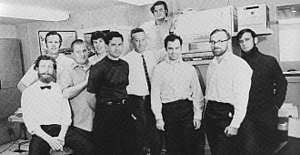Frank Heart
| Frank Heart | |
|---|---|
 IMP Team (left to right): Truett Thatch, Bill Bartell, Dave Walden, Jim Geisman, Robert Kahn, Frank Heart, Ben Barker, Marty Thorpe, Will Crowther, and Severo Ornstein | |
| Born |
Frank Evans Heart May 15, 1929 The Bronx, New York, U.S. |
| Died |
June 24, 2018 (aged 89) Lexington, Massachusetts, U.S. |
| Alma mater | Massachusetts Institute of Technology |
| Occupation | Computer engineer |
| Employer | |
| Known for | Co-designing the IMP |
| Spouse(s) |
Jane Sundgaard (m. 1959; d. 2014) |
| Children | 3 |
| Awards | Internet Hall of Fame (2014) |
Frank Evans Heart (May 15, 1929 – June 24, 2018) was an American computer engineer, who, along with a team of others, designed the first routing computer for the ARPANET, the predecessor to the Internet.
Background
Heart was born in The Bronx, New York, and grew up in Yonkers. His father was an engineer at the Otis Elevator Company; his mother was an insurance agent.[1]
Heart enrolled at the Massachusetts Institute of Technology (MIT) in 1947, entering a five-year master's degree program in which he alternated semesters between work and school. In 1951, he enrolled in MIT's new computer programming course. He became fascinated with computers and worked at the MIT Lincoln Laboratory, the university's military contractor. Heart received both bachelor's and master's degrees in electrical engineering in 1952.[1]
Career
While at Lincoln Laboratory, Heart was a research assistant on Whirlwind I, a computer that controlled a radar defense system for tracking aircraft. He worked at Lincoln until 1966, when he was recruited by Bolt, Beranek and Newman (BBN), a research and development company. In 1969, BBN won a proposal from ARPA to build the first Interface Message Processor (IMP), known today as a router, and Heart was put in charge.[1]
Heart's team used a rugged Honeywell DDP-516 minicomputer to engineer the IMP, whose special function was to switch data among the computers on the ARPANET. The team also invented remote diagnostics for computers, allowing IMPs to run unattended as much as possible, including the ability to restart by themselves after a power failure or system crash. The first machines were installed at the University of California, Los Angeles and, a few weeks later, at the Stanford Research Institute in Menlo Park, California.[1] Heart appeared in the 1972 ARPANET documentary Computer Networks: The Heralds of Resource Sharing.
In 1989, the federal government decommissioned ARPANET. Most of the IMPs were disassembled; a few remain in museums and computer labs. However, many of Heart's core principles, such as reliability and error detection and correction, still exist within the Internet.[1]
In 2014, Heart was inducted into the Internet Hall of Fame.
Personal life
While working at Lincoln Laboratory, Heart met Jane Sundgaard, one of the company's first women programmers. They married in 1959. She died in 2014.[2] He died of melanoma at age 89 in a retirement community in Lexington, Massachusetts. They are survived by three children.[1]
References
- 1 2 3 4 5 6 Hafner, Katie (June 25, 2018). "Frank Heart, Who Linked Computers Before the Internet, Dies at 89". The New York Times. Retrieved June 26, 2018.
- ↑ "Obituary: Jane Heart". May 7, 2014. Retrieved June 26, 2018.